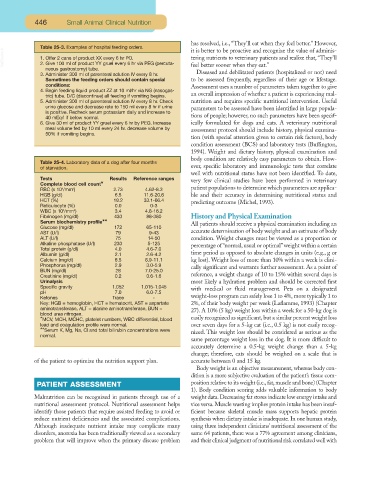Page 432 - Small Animal Clinical Nutrition 5th Edition
P. 432
446 Small Animal Clinical Nutrition
has resolved, i.e., “They’ll eat when they feel better.” However,
Table 25-3. Examples of hospital feeding orders. it is better to be proactive and recognize the value of adminis-
VetBooks.ir 1. Offer 2 cans of product XX every 6 hr PO. tering nutrients to veterinary patients and realize that, “They’ll
2. Give 100 ml of product YY gruel every 6 hr via PEG (percuta-
neous gastrostomy) tube. feel better sooner when they eat.”
3. Administer 300 ml of parenteral solution IV every 8 hr. Diseased and debilitated patients (hospitalized or not) need
Sometimes the feeding orders should contain special to be assessed frequently, regardless of their age or lifestage.
conditions: Assessment uses a number of parameters taken together to give
4. Begin feeding liquid product ZZ at 10 ml/hr via NG (nasogas-
tric) tube. D/C (discontinue) all feeding if vomiting begins. an overall impression of whether a patient is experiencing mal-
5. Administer 300 ml of parenteral solution IV every 8 hr. Check nutrition and requires specific nutritional intervention. Useful
urine glucose and decrease rate to 150 ml every 8 hr if urine parameters to be assessed have been identified in large popula-
is positive. Recheck serum potassium daily and increase to
40 mEq/l if below normal. tions of people; however, no such parameters have been specif-
6. Give 30 ml of product YY gruel every 6 hr by PEG. Increase ically formulated for dogs and cats. A veterinary nutritional
meal volume fed by 10 ml every 24 hr. decrease volume by assessment protocol should include history, physical examina-
50% if vomiting begins.
tion (with special attention given to certain risk factors), body
condition assessment (BCS) and laboratory tests (Buffington,
1994). Weight and dietary history, physical examination and
body condition are relatively easy parameters to obtain. How-
Table 25-4. Laboratory data of a dog after four months
of starvation. ever, specific laboratory and immunologic tests that correlate
well with nutritional status have not been identified. To date,
Tests Results Reference ranges very few clinical studies have been performed in veterinary
Complete blood cell count*
RBC (x 10 /mm ) 3 2.73 4.62-8.3 patient populations to determine which parameters are applica-
6
HGB (g/dl) 6.5 11.6-20.6 ble and their accuracy in determining nutritional status and
HCT (%) 18.2 33.1-66.4 predicting outcome (Michel, 1993).
Reticulocyte (%) 0.0 0-3
3
WBC (x 10 /mm ) 3 3.4 4.8-16.2
Fibrinogen (mg/dl) 430 88-380 History and Physical Examination
Serum biochemistry profile** All patients should receive a physical examination including an
Glucose (mg/dl) 172 65-110
AST (U/l) 79 9-43 accurate determination of body weight and an estimate of body
ALT (U/l) 75 14-50 condition. Weight changes must be viewed as a proportion or
Alkaline phosphatase (U/l) 230 5-125 percentage of “normal, usual or optimal” weight within a certain
Total protein (g/dl) 4.0 4.6-7.0
Albumin (g/dl) 2.1 2.6-4.2 time period as opposed to absolute changes in units (e.g., g or
Calcium (mg/dl) 8.5 8.9-11.1 kg lost). Weight loss of more than 10% within a week is clini-
Phosphorus (mg/dl) 2.9 3.0-5.9 cally significant and warrants further assessment. As a point of
BUN (mg/dl) 28 7.0-25.0
Creatinine (mg/dl) 0.2 0.6-1.6 reference, a weight change of 10 to 15% within several days is
Urinalysis most likely a hydration problem and should be corrected first
Specific gravity 1.052 1.015-1.045 with medical or fluid management. Pets on a designated
pH 7.0 6.0-7.5
Ketones Trace - weight-loss program can safely lose 1 to 4%, more typically 1 to
Key: HGB = hemoglobin, HCT = hematocrit, AST = aspartate 2%, of their body weight per week (Laflamme, 1993) (Chapter
aminotransferase, ALT = alanine aminotransferase, BUN = 27). A 10% (5 kg) weight loss within a week for a 50-kg dog is
blood urea nitrogen.
*MCV, MCH, MCHC, platelet numbers, WBC differential, blood easily recognized as significant,but a similar percent weight loss
lead and coagulation profile were normal. over seven days for a 5-kg cat (i.e., 0.5 kg) is not easily recog-
**Serum K, Mg, Na, Cl and total bilirubin concentrations were nized. This weight loss should be considered as serious as the
normal.
same percentage weight loss in the dog. It is more difficult to
accurately determine a 0.5-kg weight change than a 5-kg
change; therefore, cats should be weighed on a scale that is
of the patient to optimize the nutrition support plan. accurate between 0 and 15 kg.
Body weight is an objective measurement, whereas body con-
dition is a more subjective evaluation of the patient’s tissue com-
PATIENT ASSESSMENT position relative to its weight (i.e.,fat,muscle and bone) (Chapter
1). Body condition scoring adds valuable information to body
Malnutrition can be recognized in patients through use of a weight data. Decreasing fat stores indicate low energy intake and
nutritional assessment protocol. Nutritional assessment helps vice versa. Muscle wasting implies protein intake has been insuf-
identify those patients that require assisted feeding to avoid or ficient because skeletal muscle mass supports hepatic protein
reduce nutrient deficiencies and the associated complications. synthesis when dietary intake is inadequate. In one human study,
Although inadequate nutrient intake may complicate many using three independent clinicians’ nutritional assessment of the
disorders, anorexia has been traditionally viewed as a secondary same 64 patients, there was a 77% agreement among clinicians,
problem that will improve when the primary disease problem and their clinical judgment of nutritional risk correlated well with

